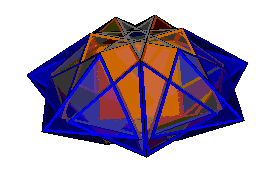
Spheno-prisms
A prismatic family exists where the two prismatic bases are connected by sphenoids. This family is 3-uniform. The base n/d-gon is this time surrounded by (type A) vertices of the form n/d.4.3.3.4 Type (B) vertices of the form 3.3.3.3 and type (C) vertices of the form 4.4.3.3 also occur. Both the type (B) and the type (C) vertices are equatorial. The type (C) vertices are also internal to the solid. The linking sphenoids are best seen in this model of the 7/3 spheno-prism where only a single loop of the sphenoids around the prismatic symmetry axis is shown. The internal structure can also be seen in this model of one hemisphere of a 7/3 spheno-prism. See also the models of the Elongated Spheno-prism for further models showing the internal structure.
The family is convex for 2 <=n/d < 3, n/d=3 is the limiting case and is planar (see below). Setting n/d=2 gives a 'disphenoid' or to give it its Johnson Solid name an elongated square dipyramid, this is the only n-gonal convex member of this family. Spheno-prisms are a specific form of edge expanded bi-prisms, or EEB's. Click here for further information about the general family of EEB's.
Note: This family is closely related to the "Accordion Polyhedra" discussed in Professor Bonnie Stewart's "Adventures Among the Toroids" 2nd Ed. pp 151. Using Professor Stewart's terminology these would be "Everted Square Plated Accordions"
The height (H) of a spheno-prism is given by:
![]()
Click here for proof.
For the n-gonal cases, this gives H=sqrt(2) for n/d=2 and proves the limiting zero height for n/d=3. The height formula can also be applied to spheno-prisms with retrograde bases (i.e. n/d<2) but in these cases the solid is not locally convex. For example the 5/3 spheno-prism
Due to the internal type (C) vertices, solid models of the solids are dominated by the type (B) vertices and are generally rather uninteresting, as the following models are HEDRON 'switch' files, I recommend viewing them in translucent mode.
A full list of locally convex spheno-prisms
with d>1 and n<=12 is below. Their retrograde equivalents are
also given.
| 5/2 | 7/3 | 8/3 | 9/4 | 11/4 | 11/5 | 12/5 |
Next: Elongated Spheno-Prisms
Back:
To Prisms
Back: To Index